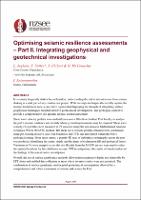| dc.description.abstract | In a country frequently shaken by earthquakes, understanding the risk to infrastructure from seismic shaking is a vital part of any construction project. With no single technique able to fully capture the seismic hazard in an area, a case study is presented displaying the strength of integrating surface geophysical techniques, targeted intrusive geotechnical investigations and geological context to provide a comprehensive site-specific seismic hazard assessment.
Shear wave velocity profiles were undertaken across a 30ha New Zealand Port Facility to analyse the port’s seismic resilience and identify where ground improvements may be required. Shear wave velocity profiles were measured at 78 locations using the non-invasive Multichannel Analysis of Surface Waves (MASW) method. Profiles obtained were constrained using pre-existing invasive data from boreholes and CPTs and interpreted within the Port’s geological setting. From these results, a pseudo-3D map of subsurface stratigraphy across the port was produced, identifying the extent, depth and thickness of reclamation fill and geological layers. Variations in Vs30 were mapped across the site. Results from the MASW survey were used to select the optimal locations for five additional seismic CPT investigations, the results of which reinforced the findings of the non-invasive investigation.
Overall, the use of surface geophysical methods allowed investigation to depths not achievable by CPT alone due to the presence of reclamation fill, and enabled data collection in areas where invasive studies were not permitted. The combination of surface geophysics and targeted geotechnical investigations allowed for a comprehensive and robust assessment of seismic risk across the Port. | |

